Making your own Mozzarella might seem like overkill, but it is surprisingly easy to do with great results! You will need a few tools and ingredients but nothing too complicated, and the smooth, creamy taste and texture of fresh homemade Mozzarella on your pizzas will have you hooked – I recommend making a double or triple batch and freezing some for later.
Note: The first step of making mozzarella is to acidify the milk. This method uses food acid to speed up the process, but if you prefer you can use a little yoghurt instead of the food acid. If using yoghurt, you would add it to the milk and allow it to sit overnight until fermented.
Tools and Ingredients
pH tester
I’m using a digital pH meter but if you don’t want to spring for a meter, pH strips will do the job just fine, but get some like these – they are more accurate than the type with just one or two colour squares. To be honest, you can probably skip the pH testing completely if you aren’t scientifically minded or don’t mind taking a chance. I don’t like my cheese to be more acidic than necessary as I feel that it affects the taste, so I do check the pH of the milk while adding acid and stop as soon as I’ve reached my target.
Tartaric Acid
In the past, I have followed recipes that called for citric acid. I have decided to use tartaric acid as I found that the citric acid left a slightly more pronounced bitterness in the finished cheese. You can substitute the tartaric for citric acid if necessary or preferred though.
Rennet
Being a little squeamish, I use this non-animal rennet and have not had any problems with it. If you prefer, traditional rennet is just fine too.
Milk
It’s important to use non homogenised milk to make mozzarella – homogenised milk does not work well if at all. Interestingly though, it is possible to use milk powder. I’ve done it, and while the cheese wasn’t as good as with fresh milk, it was better than not having any Mozzarella at all. Source your milk from a local dairy if possible, the taste of the finished cheese will reflect the quality of the milk you use.
Thermometer
You will need an accurate probe thermometer. I use an analogue one out of habit but I also have a digital version that is more accurate.
Mozzarella Recipe
Makes around 400g/1lb
| Milk | 4 litres | 4 pints |
| Tartaric Acid | 7g | 1 level tsp |
| Rennet | Per instructions | |
| Salt | 6g | 1 tsp |
- Pour the milk into a large saucepan or stock pot. Dissolve the tartaric acid in half a cup of water, then add to the milk. If using a pH tester, make up more acid solution than needed and add a tablespoon at a time while stirring well, until the milk reaches pH 5.6.
- Heat the milk to 32C/90F. I find the best way to do this is to put it over the lowest heat possible while stirring, and monitor the temperature. If it isn’t warm enough after 10 minutes or so, increase the heat slightly and continue to monitor. Once at 32C/90F, turn off the heat.
- Check the instructions for your chosen rennet and add the appropriate amount. With the one I used, I added 5 drops per litre of milk to a tablespoon of water, which was then stirred into the milk.
- Cover the pan and leave to sit for several hours. You are looking for the milk to set to the point that the curd breaks cleanly when pressed or cut.
- Cut the curd into cubes about 1cm (½ inch) apart.
- Return the pan to the heat, and slowly increase the heat to 105C. Leave at this temperature for half an hour, stirring occasionally.
- Line a colander or large sieve with cheesecloth. My guilty secret is that I never have cheesecloth handy in my kitchen – I use a clean tea towel. Don’t tell my missus! Pour the curds and whey into your lined sieve, and allow the whey to drain out for 10 minutes. Turning over the curds halfway through lets a little more whey drain out, but there’s no need to squeeze or press them. TIP: save the whey and you can make ricotta later!
- Tip your strained curds into a mixing bowl, and add the salt. Work it through, breaking up the curd as you mix.
- At this point you will have salted curd, ready to be stretched!
Stretching Mozzarella
Before it can be stretched, the curd needs to be melted. I have seen two different methods of doing this. One is to take one cup of curd at a time and microwave it for 45 seconds. The other is to tip the curd into a large bowl of hot water. Both have the potential to cause owies, but I think the hot water method is safer as the microwave can sometimes heat things more quickly and hotter than you might realise, which makes the curd dangerous to handle.
For the hot water method, boil a pan full of water, remove from the heat, and let it cool slightly. 70C/160F is enough to melt curd for stretching, but if it is a little hotter you won’t have to work so fast before it cools too much. Tip the curd into the hot water. Use tongs or a slotted spoon to pull out some curd ready to shape. It will be hot, so keep a bowl or sink full of cool water handy to dip your fingers into. If it’s too hot to handle, wear rubber gloves.
Stretch the curd out and fold it over itself a few times. You will see it start to look shiny as you work it.
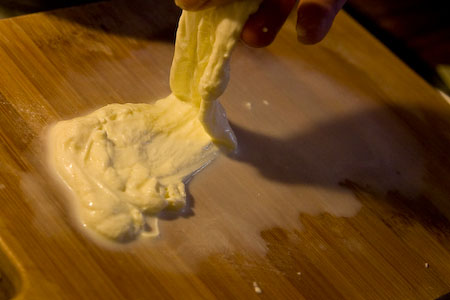
Shape it into a ball by making a ring with your thumb and forefinger and holding the piece in between. Continuously tuck the curd up inside itself until you have a neat ball, Squeeze your thumb and forefinger together to seal the end. You can shape either big or small balls as desired. When shaped, drop each ball into a bowl of cold salt water – I use 1 tbsp per litre of water.
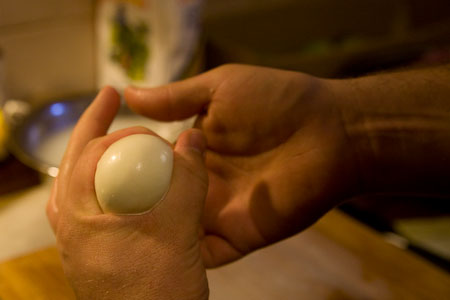
Finished! You can store your mozzarella balls in the salt water, or remove them when cool and store in a bowl or bag. For pizza use it’s probably more sensible to store dry, to avoid soggy bases. Fresh mozzarella should keep for a few days in the fridge, or longer frozen.
To Make Ricotta
Boil the strained whey vigorously for a few minutes. Pour into a cheesecloth lined sieve. Tie the ends of the cloth with string and hang from something overnight.

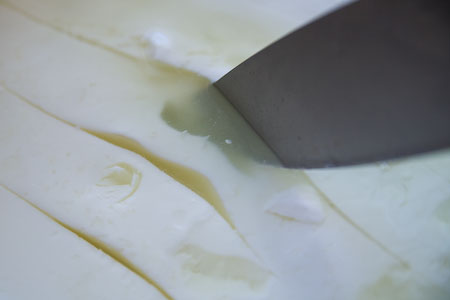
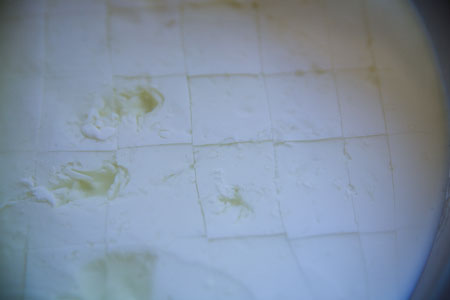
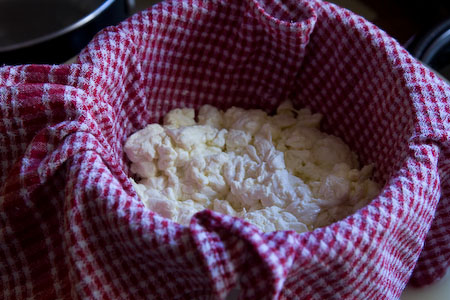
Hello! Are you still using that pH meter and is it any good?
Hi! Yes I still use the meter I pictured – it is excellent, but I think the cheaper ones probably work well too!
You must use use vinegar for making ricotta to increase the yield